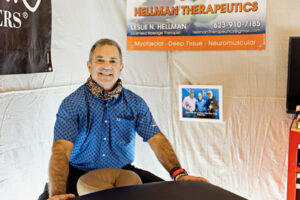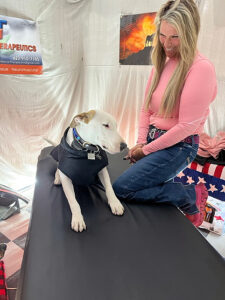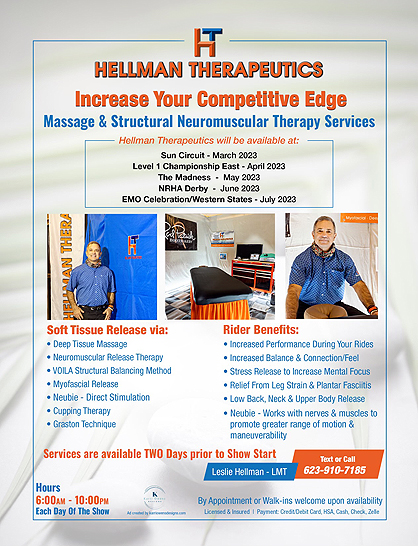Leslie Hellman of Hellman Therapeutics: Powered by Hands
By Delores Kuhlwein
There’s a meme that gets passed around social media every so often and it brings plenty of laughs, mostly because of the ring of truthfulness.
People: Aren’t horses expensive?
Me: As long as you don’t spend on luxury items like such as food or basic health care, it’s fine.
It’s oh-so true that often horse people make taking care of themselves the last priority on their to-do lists, but a familiar face at the horse shows is beginning to swing the pendulum the other way to create a balance.
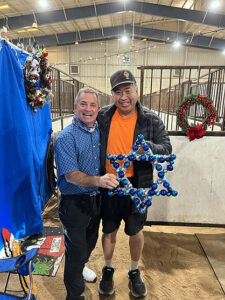 Licensed Massage Therapist (LMT) Leslie Hellman has been offering his massage and structural neuromuscular therapy services to bring relief to AQHA circuit exhibitors for the past 5 ½ years. Right away when you meet him, you understand he’s genuine and passionate about helping the rider, and those qualities accompany his ability to understand the unique injuries of the rider.
Licensed Massage Therapist (LMT) Leslie Hellman has been offering his massage and structural neuromuscular therapy services to bring relief to AQHA circuit exhibitors for the past 5 ½ years. Right away when you meet him, you understand he’s genuine and passionate about helping the rider, and those qualities accompany his ability to understand the unique injuries of the rider.
“My goal is to be able to reach as many riders as I can and help them, and from what people have told me, there hasn’t been anyone else who does what I do,” says Leslie. “So I do everything I can to let people know I’m here and I care. I ask them what I can do to help, and what they need and want.”
In fact, the first visit for a client (in a stall that’s fully enclosed and sealed for privacy, with heat, air conditioning and an air purifier), the first question you’ll be asked is about what is physically wrong. “You’re in a safe area, and the more honest you are, the better I can assist you. When clients come in, I ask if they’re looking for a massage or if they have injuries,” he says.
Immersed in the Horse Industry
Though he’s been an LMT for many years, with experiences such as the official LMT for the White Sox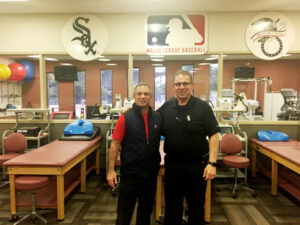 and Padres Spring Training while living in Arizona, he began his venture into the horse industry first as horse show staff with the Arizona Paint Horse Club and the Arizona Quarter Horse Association. Then he began to offer his services to that population after learning many of them struggle with injuries – and they were the last to take care of themselves.
and Padres Spring Training while living in Arizona, he began his venture into the horse industry first as horse show staff with the Arizona Paint Horse Club and the Arizona Quarter Horse Association. Then he began to offer his services to that population after learning many of them struggle with injuries – and they were the last to take care of themselves.
“I met Jill Newcomb and Murray Griggs, and worked on them as pro athletes, and I found out how dehydrated they were and that my touch needed to be refined for a different group. After 4 or 5 months of helping them, Jill asked me to try going on the road,” he explains. “It’s because of Jill and Murray I’m here to help the riders.”
He started at Sun and Surf and quickly found all his appointments filled, then he went on to the EMO Celebration and NSBA World with a packed schedule . “I couldn’t believe it,” he says. “No one was working with the riders, and people were injured, and the therapists the amateurs and trainers were seeing didn’t quite have an understanding of the kinesiology of the rider.”
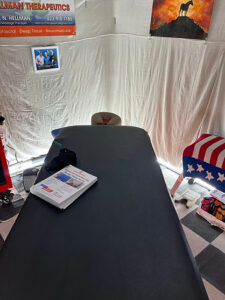 As an athlete himself who had competed in Ironman Triathlons, hockey, baseball, La Crosse, and soccer, Leslie applied his past knowledge and dedicated himself to learning about the range of motion and movements necessary to the horse industry.
As an athlete himself who had competed in Ironman Triathlons, hockey, baseball, La Crosse, and soccer, Leslie applied his past knowledge and dedicated himself to learning about the range of motion and movements necessary to the horse industry.
Addressing the Rider’s Needs
“I was working with Major League Baseball at their Spring Training and several pitchers from the Texas Rangers individually, but the injuries I see in the horse industry, I don’t see at a PT office. And yet over the 5 ½ years, I have figured out how to not only do the corrections but do the releases to aid them,” he explains. “If the hip is off or the pelvis is off, they cannot get the body squared like they need to. I can fix them so they can ride more efficiently and effectively – I also spend a tremendous amount of time on hip and knee injuries.”
He reveals that lack of alignment is both structural and muscular in nature. “I get the structure back into alignment and then we can work on the muscles.”
Leslie also addresses hydration with the riders, because he understands ¾ of Americans don’t have enough water or fluid in them. “If you weight 160 pounds, you should drink 80 ounces of water a day,” he reveals. “I’m also a big proponent of Body Armor, because the minerals bring you up naturally with no sugar rush. If I know someone is dehydrated, I have them start drinking one during the session.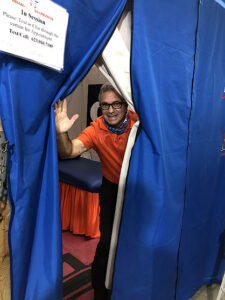
As he learned the riders’ kinesiology and its needs, he applied himself to obtaining the licenses he needed for each show he worked, which now total nine state licenses, and he continued his quest to learn new modalities for helping others – especially riders. “My continuing education costs are $5-10k annually, whether online or at a venue. When I learn a new modality, I have to practice it and perfect it so when I got to the horse shows, I have a new modality to offer,” he explains.
As an LMT, Leslie understands how the muscles work or “fire” in different situations, and often he starts a session with structural work, followed by neuromuscular work. The goal is to get the muscles to release, and he applies modalities like Myofascial Release, which allows the fascia to release, using a short stroke technique to those who suffer from chronic pain. “I also will put in ART (active release techniques), another modality, which allows the muscle to be released and allows them to get better range of motion.”
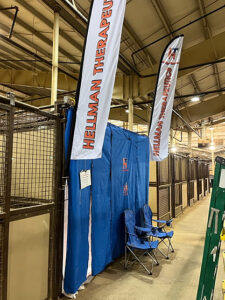 Leslie’s current list of services is impressive: Deep Tissue Massage, Neuromuscular Release Therapy, VOILA Structural Balancing Method, Myofascial Release, Cupping Therapy, Graston Technique, and Kinesio Taping, and he actually holds certifications in VOILA Method, Neuromuscular, Graston Technique, Cupping Therapy, and Kinesio Taping.
Leslie’s current list of services is impressive: Deep Tissue Massage, Neuromuscular Release Therapy, VOILA Structural Balancing Method, Myofascial Release, Cupping Therapy, Graston Technique, and Kinesio Taping, and he actually holds certifications in VOILA Method, Neuromuscular, Graston Technique, Cupping Therapy, and Kinesio Taping.
One of the newest modalities he has added to help riders feel their best is called Neufit Therapy. “Their stimulation machine is called the Neubie, and it’s one of the most powerful direct current machines available at this time,” he explains. “I can adapt to an area, and open up that muscle area, with pads or a glove. With the glove I can actually massage and open up the nerve and muscle pathways. We’re opening up the nervous system to connect, and I’m trying to connect the brain to the movement. If someone has RA, for example, I can have their hands moving as a young person again.”
Most of all, his dedication to the highest level of service of helping today’s riders is evident upon first meeting him, or when considering his hours at the show: 6 AM to 10 PM each day, and he’ll stretch those hours longer if he’s needed. “Sometimes I’ll stay until midnight if that’s what I have to do. If you thoroughly enjoy what you do, you’ll come in early or stay late because you know they’re injured,” Leslie says. “I keep a cancellation list of people so they know I’m trying to get them in somewhere. You have to be willing to be there different hours because the trainers can’t be there on an 8-hour schedule.”
The longtime Arizona resident of 17 years, who took care of his mom and dad for 15 of those years, recently moved to Dothan, Alabama, due to his acute asthma. The more central location also enabled Leslie to add four additional shows to his schedule.
“If treating your injury allows you to get better, and takes some of the pain and agony away, is that worth it to you? We have to take care of ourselves as well as we take care of our horses and our vehicles,” he declares. “The beauty of watching people feel different on their horse and be able to work together better is the greatest reward for me.”
Leslie’s show schedule and more details can be found on the Hellman Therapeutics state-of-the-art website, https://www.hellmantherapeutics.com/
Pro photos credit: Danielle Long










